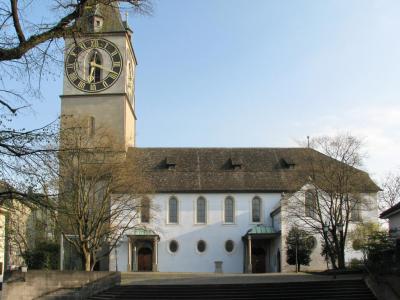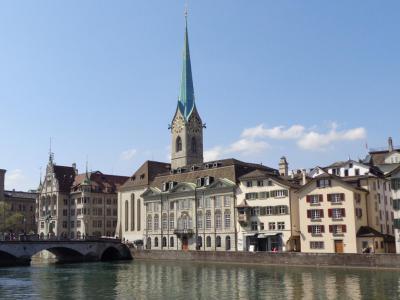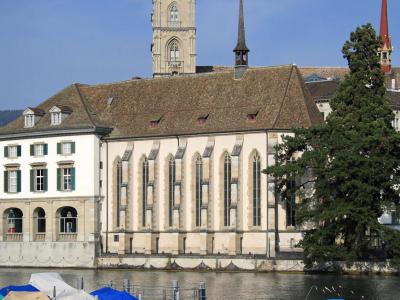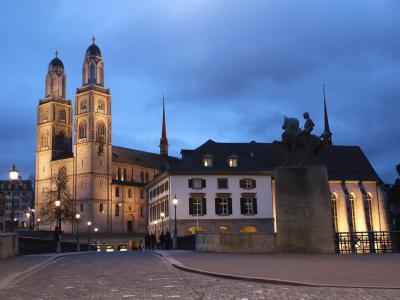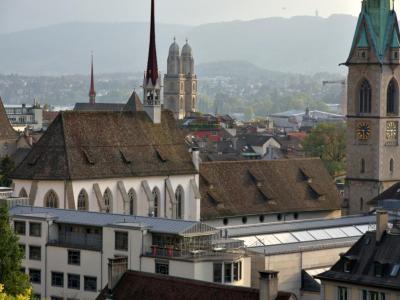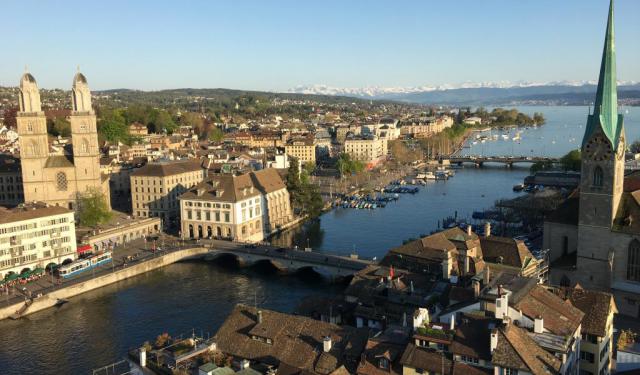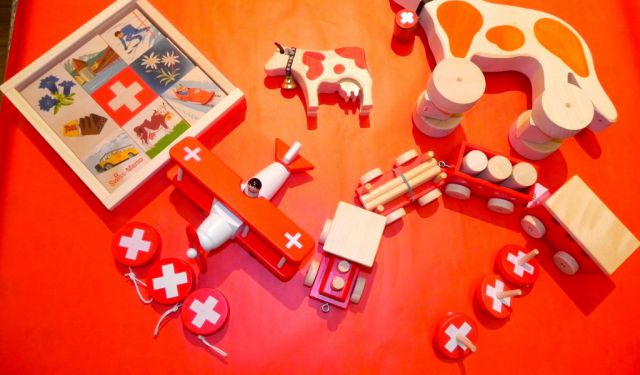Zurich's Historical Churches Tour (Self Guided), Zurich
The history of Christianity in Zurich is duly reflected in the local churches, found here in abundance. Indeed, Christianity has been the dominant religion of Zurich for many centuries. And while, historically, the city was a center of the Protestant Reformation, today it is home to both Catholic and Protestant communities.
The Swiss Reformed Church is the largest Protestant denomination, but there are also several Roman Catholic churches, too. Alongside the “mainline” Christian communities, the city hosts some smaller ones as well, like the Orthodox and Evangelical.
There is a saying: "Zwingli started it, but Calvin finished it." This refers to the role of two influential Protestant reformers in shaping the religious landscape of Europe. Ulrich Zwingli, a 16th-century Swiss pastor, preached his reform ideas at the Grossmünster (Great Minster), which is now one of the most recognizable landmarks of Zurich.
Just across the river, in the Old Town, is the Fraumünster (Church of Our Lady) – once part of the Benedictine abbey, now famous for its association with the Russian-French artist Marc Chagall. Topping the hill, a few blocks away, is yet another religious site of distinction, the St Peterskirche (St Peter's Church), the oldest church in the city, dating from the 9th century, also boasting the largest clock in Europe.
Apart from being acknowledged for their architecture, the historical churches of Zurich offer a glimpse into the city's religious past and cultural present. Those who are interested in familiarizing themselves with both more closely will benefit from this walking tour.
The Swiss Reformed Church is the largest Protestant denomination, but there are also several Roman Catholic churches, too. Alongside the “mainline” Christian communities, the city hosts some smaller ones as well, like the Orthodox and Evangelical.
There is a saying: "Zwingli started it, but Calvin finished it." This refers to the role of two influential Protestant reformers in shaping the religious landscape of Europe. Ulrich Zwingli, a 16th-century Swiss pastor, preached his reform ideas at the Grossmünster (Great Minster), which is now one of the most recognizable landmarks of Zurich.
Just across the river, in the Old Town, is the Fraumünster (Church of Our Lady) – once part of the Benedictine abbey, now famous for its association with the Russian-French artist Marc Chagall. Topping the hill, a few blocks away, is yet another religious site of distinction, the St Peterskirche (St Peter's Church), the oldest church in the city, dating from the 9th century, also boasting the largest clock in Europe.
Apart from being acknowledged for their architecture, the historical churches of Zurich offer a glimpse into the city's religious past and cultural present. Those who are interested in familiarizing themselves with both more closely will benefit from this walking tour.
How it works: Download the app "GPSmyCity: Walks in 1K+ Cities" from Apple App Store or Google Play Store to your mobile phone or tablet. The app turns your mobile device into a personal tour guide and its built-in GPS navigation functions guide you from one tour stop to next. The app works offline, so no data plan is needed when traveling abroad.
Zurich's Historical Churches Tour Map
Guide Name: Zurich's Historical Churches Tour
Guide Location: Switzerland » Zurich (See other walking tours in Zurich)
Guide Type: Self-guided Walking Tour (Sightseeing)
# of Attractions: 5
Tour Duration: 1 Hour(s)
Travel Distance: 1.2 Km or 0.7 Miles
Author: ellen
Sight(s) Featured in This Guide:
Guide Location: Switzerland » Zurich (See other walking tours in Zurich)
Guide Type: Self-guided Walking Tour (Sightseeing)
# of Attractions: 5
Tour Duration: 1 Hour(s)
Travel Distance: 1.2 Km or 0.7 Miles
Author: ellen
Sight(s) Featured in This Guide:
- St. Peterskirche (St. Peter's Church)
- Fraumünster (Church of Our Lady)
- Wasserkirche (Water Church)
- Grossmünster (Great Minster)
- Preacher's Church (Predigerkirche)
1) St. Peterskirche (St. Peter's Church) (must see)
Saint Peter's Church-Zurich’s oldest temple-is also, quite possibly, the city’s most punctual landmark. Built in the 9th century, this beauty has seen more centuries than your local pub’s clock has seen beers. And speaking of clocks, St. Peter’s claims the biggest clock face in all of Europe. At a whopping 8.6 meters in diameter, its minute hand alone is longer than most compact cars. No excuse for being late around here...
The church got some facelifts over the years-first in the 13th century and again in the 1700s-because, indeed, medieval landmarks deserve a little renovation every now and then. Until 1911, a firewatcher lived in the steeple, popping his head out the window four times an hour to scan for smoke. If flames were spotted, he’d wave a flag in the direction of the danger-simple, low-tech, and surprisingly effective. Thus, unlike many of its European cousins, Zurich avoided catastrophic fires. It turns out that medieval flag signals are not just for parades...
Inside the church, you’ll find a Baroque nave paired with a Romanesque choir-like architectural speed dating through the centuries. Look closely at the faded murals, and you might spot a saint lurking in the shadows. Above the pulpit, the name of God appears in Hebrew, a nod to the Reformation’s love for the Bible’s original languages. Think of it as ancient theological street cred...
Now here’s the kicker: Saint Peter’s Church has shared custody. The City of Zurich owns the tower, while the Swiss Reformed Church parish holds the rights to the bells, the belfry, and the staircase. It is, indeed, church co-parenting at its finest...
Tip for the savvy traveler: Admire it up close, but for peak Instagram potential, cross the river-the church is even prettier from a distance.
The church got some facelifts over the years-first in the 13th century and again in the 1700s-because, indeed, medieval landmarks deserve a little renovation every now and then. Until 1911, a firewatcher lived in the steeple, popping his head out the window four times an hour to scan for smoke. If flames were spotted, he’d wave a flag in the direction of the danger-simple, low-tech, and surprisingly effective. Thus, unlike many of its European cousins, Zurich avoided catastrophic fires. It turns out that medieval flag signals are not just for parades...
Inside the church, you’ll find a Baroque nave paired with a Romanesque choir-like architectural speed dating through the centuries. Look closely at the faded murals, and you might spot a saint lurking in the shadows. Above the pulpit, the name of God appears in Hebrew, a nod to the Reformation’s love for the Bible’s original languages. Think of it as ancient theological street cred...
Now here’s the kicker: Saint Peter’s Church has shared custody. The City of Zurich owns the tower, while the Swiss Reformed Church parish holds the rights to the bells, the belfry, and the staircase. It is, indeed, church co-parenting at its finest...
Tip for the savvy traveler: Admire it up close, but for peak Instagram potential, cross the river-the church is even prettier from a distance.
2) Fraumünster (Church of Our Lady) (must see)
The Church of Our Lady-or Fraumünster if you're feeling Swiss about it-is easily one of Zurich’s most eye-catching landmarks, thanks to that graceful blue spire that insists on being in every skyline photo. Founded way back in 853 by Emperor Louis the German for his daughter Hildegard (talk about a royal housewarming gift), this wasn’t an average cloistered convent. No, the abbess here wasn’t just praying and gardening-she was running the show. In medieval Zurich, she held market rights, minted coins, and had a firm grip on city affairs. Basically, before Zurich was ruled by bankers in suits, it was partly governed by nuns with serious executive power.
By 874, they’d added a basilica complete with a crypt that now houses Zurich’s patron saints, Felix and Regula-because a great city can certainly benefit from a couple of martyred siblings watching over it. But the good times for the abbey came to an end in 1524 during the Reformation. The last abbess handed the keys over to the city, and most of the religious art was either taken down or..., well, aggressively removed.
Today, people come not just for the medieval intrigue, but for the stunning mashup of Gothic architecture and Baroque flair. And then-boom-the stained glass. In the 1970s, none other than Marc Chagall himself stepped in and created five towering windows for the choir. Each one tells a biblical story in bold, glowing color. The “Prophet” window is all reds and oranges and righteous fire. Across from it are “Jacob,” “Christ,” and “Zion” in cooler, gentler hues, and the “Law” window fit to impress even Moses himself.
Also remarkable is the vibrant window near the entrance by Augusto Giacometti, adding another layer of artistic prestige to the church’s interior. So now it doubles as an accidental art museum.
If you're visiting, do grab the audio guide-it’s included with the ticket and actually quite good. You’ll get the full story, minus the Latin. Entry fees vary, and remember: while photos of the interior are generally allowed, pictures of the Chagall windows are strictly prohibited. Your phone will be tempted, but resist. Oh, and be sure to bring some Swiss francs, too-they still like their cash here.
So, whether you’re into saints, stained glass, or just need a break from the Station Street, the Church of Our Lady is a peaceful detour into Zurich’s soul-with a splash of color and a whole lot of history.
By 874, they’d added a basilica complete with a crypt that now houses Zurich’s patron saints, Felix and Regula-because a great city can certainly benefit from a couple of martyred siblings watching over it. But the good times for the abbey came to an end in 1524 during the Reformation. The last abbess handed the keys over to the city, and most of the religious art was either taken down or..., well, aggressively removed.
Today, people come not just for the medieval intrigue, but for the stunning mashup of Gothic architecture and Baroque flair. And then-boom-the stained glass. In the 1970s, none other than Marc Chagall himself stepped in and created five towering windows for the choir. Each one tells a biblical story in bold, glowing color. The “Prophet” window is all reds and oranges and righteous fire. Across from it are “Jacob,” “Christ,” and “Zion” in cooler, gentler hues, and the “Law” window fit to impress even Moses himself.
Also remarkable is the vibrant window near the entrance by Augusto Giacometti, adding another layer of artistic prestige to the church’s interior. So now it doubles as an accidental art museum.
If you're visiting, do grab the audio guide-it’s included with the ticket and actually quite good. You’ll get the full story, minus the Latin. Entry fees vary, and remember: while photos of the interior are generally allowed, pictures of the Chagall windows are strictly prohibited. Your phone will be tempted, but resist. Oh, and be sure to bring some Swiss francs, too-they still like their cash here.
So, whether you’re into saints, stained glass, or just need a break from the Station Street, the Church of Our Lady is a peaceful detour into Zurich’s soul-with a splash of color and a whole lot of history.
3) Wasserkirche (Water Church)
Inside the Water Church, Zurich’s history flows just as steadily as the Limmat River beneath it. First mentioned in 1250, but with roots going all the way back to the 1100s, this church wasn’t just built near the water-it was built on it. Originally perched on a little island in the river, it looked like it was doing the medieval version of island life before it was cool. By 1486, it got a full makeover-think of it as a 15th-century home renovation, but with more stained glass and fewer Instagram reels.
Then came the Reformation, and let’s just say the Water Church’s spiritual career hit a speed bump. Reformers, unimpressed by its "idolatrous" vibe, gave it a secular upgrade-making it Zurich’s very first public library in 1634. So, yes, before the Kindle, there was the Water Church...
During the 1800s, the island it sat on got connected to the mainland (bye-bye, island mystique), and by 1917, the library moved out. The church, now unemployed, found a new gig-grain storage. Holy wheat, indeed...
In the 1940s, archaeologists and restorers gave the building some long-overdue tender loving care. The crypt was dusted off, the walls were reinforced, and by the time the renovations were done, the church was back in the business of being a place of worship-this time serving the Evangelical-Reformed State Church of Zurich.
But history aside, the Water Church stands on solemn ground. Legend has it that Zurich’s patron saints, Felix and Regula, were executed right here after refusing to persecute Christians. Decapitated, yes-but apparently they stood up and walked off with their heads. As saints sometimes do...
Coming here, you'll find a serene, quiet corner of Zurich where you can catch your breath, contemplate eternity, or just admire the stunning Giacometti windows and explore the mysterious crypt below. Divine inspiration not guaranteed-but a moment of peace is highly likely.
Then came the Reformation, and let’s just say the Water Church’s spiritual career hit a speed bump. Reformers, unimpressed by its "idolatrous" vibe, gave it a secular upgrade-making it Zurich’s very first public library in 1634. So, yes, before the Kindle, there was the Water Church...
During the 1800s, the island it sat on got connected to the mainland (bye-bye, island mystique), and by 1917, the library moved out. The church, now unemployed, found a new gig-grain storage. Holy wheat, indeed...
In the 1940s, archaeologists and restorers gave the building some long-overdue tender loving care. The crypt was dusted off, the walls were reinforced, and by the time the renovations were done, the church was back in the business of being a place of worship-this time serving the Evangelical-Reformed State Church of Zurich.
But history aside, the Water Church stands on solemn ground. Legend has it that Zurich’s patron saints, Felix and Regula, were executed right here after refusing to persecute Christians. Decapitated, yes-but apparently they stood up and walked off with their heads. As saints sometimes do...
Coming here, you'll find a serene, quiet corner of Zurich where you can catch your breath, contemplate eternity, or just admire the stunning Giacometti windows and explore the mysterious crypt below. Divine inspiration not guaranteed-but a moment of peace is highly likely.
4) Grossmünster (Great Minster) (must see)
Now, if Zurich’s skyline had a king of the hill, it would probably be the Great Minster-standing tall, proud, and unmistakably Romanesque. It’s one of the city’s four major churches, rubbing historic shoulders with The Church of Our Lady, Preacher's Church, and Saint Peter's Church. But this one’s got some serious theological swagger.
Legend credits none other than Emperor Charlemagne-yes, that Charles the Great-with commissioning the place. Construction kicked off around 1100, and after about 120 years of medieval bricklaying, the Great Minster was born.
But here’s where it gets spicy: in the early 1500s, this church didn’t just host sermons-it became ground zero for the Swiss-German Reformation. Huldrych Zwingli, local priest and full-time disruptor, began preaching bold new ideas in 1520. By 1523, after winning a couple of intense theological debates, Zurich officially seceded from the Pope.
Zwingli’s influence ran deep. In 1524, the interior of the Great Minster underwent a makeover-with religious imagery, altars, and even the organ stripped away. Fasting was declared optional. Mass got rewritten. Celibacy-rethought. Church music? Well… eventually it made a comeback. What’s left is a beautifully bare, historically loaded space that tells the story of faith meeting reform head-on.
And speaking of Charles the Great, you’ll spot him again as a statue perched on the southern tower-sword in hand, crown slipping stylishly off his head like a medieval mic drop. The man unified a good chunk of Europe and even lent his name to the word “king” in many languages. Not bad for a guy in stone.
Okay, the church may seem a little plain inside-but don’t let that fool you. The stained-glass windows made from sliced agate are pure magic. The Carolus Magnus statue is iconic. And the front door alone could earn its own Instagram account.
Tip:
Feeling ambitious? Climb the tower-just 180+ steps up. No lift, no turning back. But once you’re up there, the views of Zurich are unbeatable, and best of all, you can catch your breath for as long as you like.
Legend credits none other than Emperor Charlemagne-yes, that Charles the Great-with commissioning the place. Construction kicked off around 1100, and after about 120 years of medieval bricklaying, the Great Minster was born.
But here’s where it gets spicy: in the early 1500s, this church didn’t just host sermons-it became ground zero for the Swiss-German Reformation. Huldrych Zwingli, local priest and full-time disruptor, began preaching bold new ideas in 1520. By 1523, after winning a couple of intense theological debates, Zurich officially seceded from the Pope.
Zwingli’s influence ran deep. In 1524, the interior of the Great Minster underwent a makeover-with religious imagery, altars, and even the organ stripped away. Fasting was declared optional. Mass got rewritten. Celibacy-rethought. Church music? Well… eventually it made a comeback. What’s left is a beautifully bare, historically loaded space that tells the story of faith meeting reform head-on.
And speaking of Charles the Great, you’ll spot him again as a statue perched on the southern tower-sword in hand, crown slipping stylishly off his head like a medieval mic drop. The man unified a good chunk of Europe and even lent his name to the word “king” in many languages. Not bad for a guy in stone.
Okay, the church may seem a little plain inside-but don’t let that fool you. The stained-glass windows made from sliced agate are pure magic. The Carolus Magnus statue is iconic. And the front door alone could earn its own Instagram account.
Tip:
Feeling ambitious? Climb the tower-just 180+ steps up. No lift, no turning back. But once you’re up there, the views of Zurich are unbeatable, and best of all, you can catch your breath for as long as you like.
5) Preacher's Church (Predigerkirche)
The Preacher’s Church, located in Zurich’s Old Town, has a long history in the city. The first mention of the church in records dates back to 1213, when it served as a preacher’s church. It was run by monks of the Dominican order who focused on spreading the word of the church. In the 1500s, reformation in Switzerland, lead by Ulrich Zwingli, resulted in the Predigerkirche becoming Protestant. During the time of the Reformation, much of the elegant ornamentation was removed from the church.
The building features Gothic forms, with one side visible from the street and the other side integrated into the city’s central library. The library is located on the site of a former monastery that was also shuttered during the Reformation. The church experienced many renovations and restorations. The main form of the church that is visible today dates back to the early 1600s. A steeple was added in 1899, the work of architect Gustav Gull.
Today, the church is primarily Protestant; however, it does employ a Catholic priest and occasionally has celebratory masses with Muslims and Buddhists. It draws immigrants from a variety of faiths. The church is open seven days a week to parishioners and visitors alike.
The building features Gothic forms, with one side visible from the street and the other side integrated into the city’s central library. The library is located on the site of a former monastery that was also shuttered during the Reformation. The church experienced many renovations and restorations. The main form of the church that is visible today dates back to the early 1600s. A steeple was added in 1899, the work of architect Gustav Gull.
Today, the church is primarily Protestant; however, it does employ a Catholic priest and occasionally has celebratory masses with Muslims and Buddhists. It draws immigrants from a variety of faiths. The church is open seven days a week to parishioners and visitors alike.
Walking Tours in Zurich, Switzerland
Create Your Own Walk in Zurich
Creating your own self-guided walk in Zurich is easy and fun. Choose the city attractions that you want to see and a walk route map will be created just for you. You can even set your hotel as the start point of the walk.
Zurich Gourmet Tour
Apart from its high-quality watches, Switzerland is famous for its unique delicacies. The secrets of their making have been preserved for centuries and passed on from father to son. In this respect, it is not at all surprising that a global banking and financial center such as Zurich can be also a haven for food enthusiasts seeking gourmet delights. On this self-guided walk, we invite you to... view more
Tour Duration: 1 Hour(s)
Travel Distance: 2.1 Km or 1.3 Miles
Tour Duration: 1 Hour(s)
Travel Distance: 2.1 Km or 1.3 Miles
Zurich Introduction Walking Tour
Zurich-Switzerland’s largest city and possibly the classiest time machine you’ll ever stroll through. Beneath its polished surface of banks, trams, and world-class chocolate lies a city with roots older than most empires. Humans have been hanging out here for over 6,000 years, and in 15 BC the Romans finally gave it a name: Turicum-meaning “the place of Turos”, likely stemming from a... view more
Tour Duration: 2 Hour(s)
Travel Distance: 2.9 Km or 1.8 Miles
Tour Duration: 2 Hour(s)
Travel Distance: 2.9 Km or 1.8 Miles
Old Town Walk
Zurich’s Old Town-the city’s historical core-is where the past shakes hands with charm and refuses to be boring. Spread on both sides of the Limmat River, this part of town still remembers when cobblestones were cutting-edge tech. They say “Zurich is a city, but Old Town is a village”-and yes, that pretty much nails it. A sort of medieval postcard with a side of espresso...
Old Town... view more
Tour Duration: 1 Hour(s)
Travel Distance: 1.4 Km or 0.9 Miles
Old Town... view more
Tour Duration: 1 Hour(s)
Travel Distance: 1.4 Km or 0.9 Miles
Zurich Souvenir Shopping
Zurich has no shortage of tourists, and when it comes to souvenirs, there are plenty of options available.
A popular saying goes, "When in Zurich, shop on Bahnhofstrasse." True, in terms of souvenir shopping, this thoroughfare is second to none. Another saying is that “When in Switzerland, buy Swiss-made products.”
Alongside many other things, Bahnhofstrasse is home to... view more
Tour Duration: 2 Hour(s)
Travel Distance: 2.5 Km or 1.6 Miles
A popular saying goes, "When in Zurich, shop on Bahnhofstrasse." True, in terms of souvenir shopping, this thoroughfare is second to none. Another saying is that “When in Switzerland, buy Swiss-made products.”
Alongside many other things, Bahnhofstrasse is home to... view more
Tour Duration: 2 Hour(s)
Travel Distance: 2.5 Km or 1.6 Miles
Useful Travel Guides for Planning Your Trip
15 Distinctively Swiss Things to Buy in Zurich
Zurich is Switzerland’s largest city, and although it may feel like a bustling metropolis, the tranquil essence of the Alps flows fervently through the lively cobblestone streets, the buzzing train station, and the frenzied designer boutiques. Most shops in downtown Zurich open at 9 am and close...
The Most Popular Cities
/ view all



